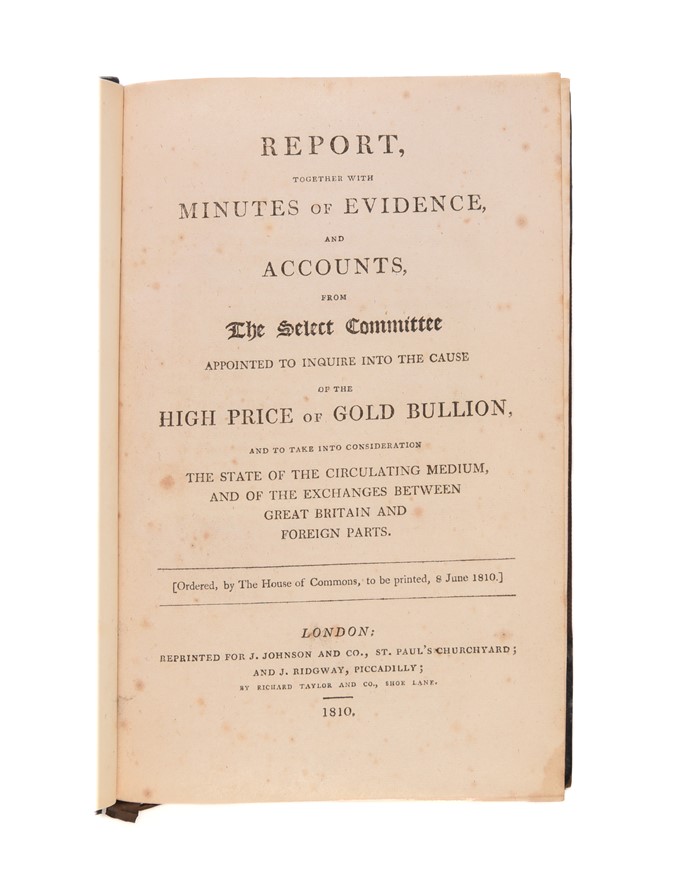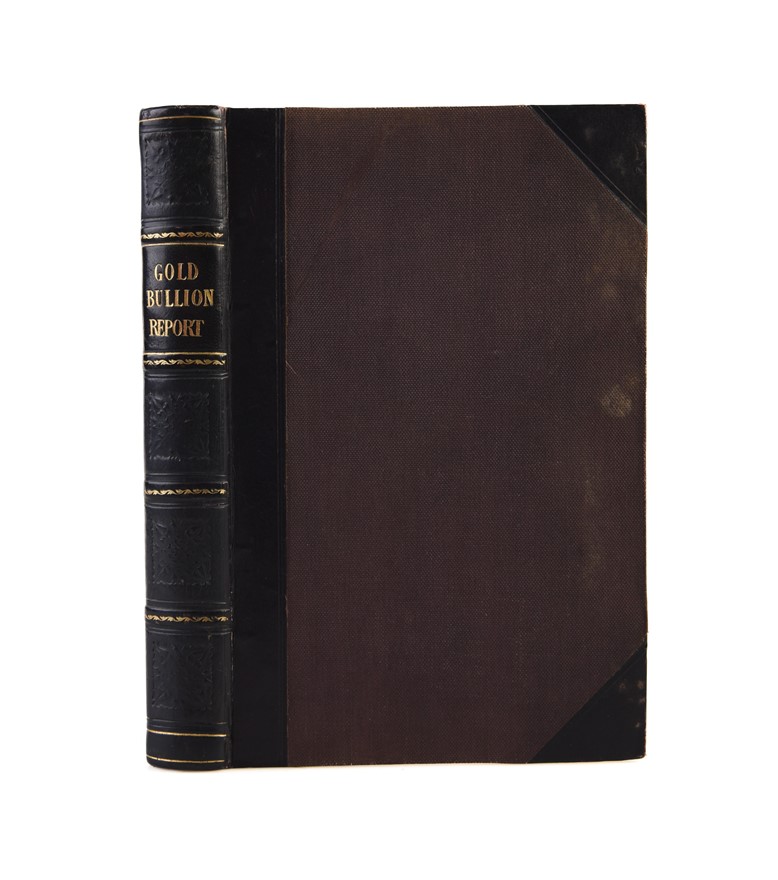Report, Together with Minutes of Evidence, and Accounts, from the Select Committee appointed to Inquire into the Cause of the High Price of Gold Bullion, and to take into Consideration the State of the Circulating Medium, and of the Exchanges between Great Britain and Foreign Parts. [Ordered, by The House of Commons, to be printed, 8 June 1810.]
BULLION REPORT (1810.)
£650.00
Available to view at our Curzon Street shop.
Second octavo edition (third overall). 8vo. x, [2], 78; [2], 237, [1, blank]; [2], 115, [1] pp. Nineteenth century black half calf with brown cloth covered boards, spine with four single raised bands outlined in gilt, second panel lettered in gilt, the rest with decorative blind stamps, marbled endpapers, ribbon place marker (lightly foxed and browned, a couple of pages in one gathering worse than elsewhere, still an excellent copy). London, reprinted for J. Johnson and Co.
'The Bullion Report of 1810 holds a unique place in monetary controversy. It is probably the most famous public document in the history of economics' (Fetter, p. 152).
In February 1810, the House of Commons set up the Select Committee on the High Price of Gold Bullion, to investigate why the price had risen during the Napoleonic Wars. Since the Bank of England ceased to redeem its bank notes in gold in 1797 due to the erosion of its reserves by the war, the price of gold was up 20%, thereby ending many decades of gold at £4.25 per ounce as established in 1717 by Isaac Newton as Master of the Mint. Evidence was given by the Governor of the Bank of England and the Clerk of its Bullion Office, Nathan Mayer Rothschild (appearing anonymously), and also refiners, brokers, merchants, and exchange dealers, their testimony printed in the appendix (and consequently giving a unique insight into the gold trade in London). The Committee concluded that the Bank, released from the obligation of paying gold against notes, had printed them too freely. As a result there was 'an excess in the paper circulation. this excess is to be ascribed to the want of a sufficient check and control in the issue of paper from the Bank of England; and originally to the suspension of cash payments, which removed the natural and true control' (p. 73 of Report). The Committee urged the Bank to resume specie payments at the earliest possible date, a resumption that did not occur until 1821. The fame of the Report 'must be explained not on the basis of logic [the Report itself a clumsy rehashing of old doctrines, in the opinion of its Chairman], but in terms of economics as part of the living fabric of political life. It brought forcibly into public attention a great issue of economic policy, and it gave the prestige of a Parliamentary Committee to the view that the money supply is an importance influence on money and on exchange rates. Even for many who might disagree with some of the analysis it became a symbol of the view that a central bank should pay attention to the monetary circulation if prices were to be restrained and exchange stability maintained' (Fetter, p. 152).
The Report was originally published in August 1810 in a small number of copies printed in folio for official use. This was followed by a trade edition printed in octavo format on 23 September 1810 and was reprinted again in December 1810 in the present second octavo edition which is to the first octavo edition except that the title page carries the full name of the Report, involving the additional words 'and to take into Consideration The State of The Circulating Medium, and of The Exchanges Between Great Britain and Foreign Parts', and that the name of 'Rt. Hon. Charles Long', omitted from the list of members in the first octavo edition, is here included.' (Fetter).
See: Frank Whitson Fetter, 'The Editions of the Bullion Report', Economica.
Stock Code: 250348





